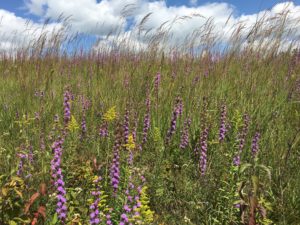The Indiangrass Hills
It was a half century ago when a young Richard Sanders Rhodes came to the Geology Department at the University of Iowa to earn a PhD studying vertebrate paleontology. His field project was in the Ice Age river sediments of southwest Iowa. He processed large quantities of sediment to obtain little teeth and small bones, which few others would have the patience to do. His goal was to understand former ecosystems there, as seen through the fossil animal assemblage. Along the way he began using modern ecosystems as analogies and references to the fossil ones.
While evaluating our modern ecosystems, he also noted how much they had been altered during the past two centuries, and he realized how quickly the few remaining examples were being destroyed. His interest turned increasingly toward salvaging what could be saved in today’s world. I remember him patiently clearing a firebreak around Williams Prairie by hand, and then even more patiently plucking aspen seedlings by the bushel from the wet mesic prairie.
Eventually he had fallen in love with enough native remnants that he wanted one of his own. And in the process of burning and managing prairie/savanna remnants, he had met Mary Brown and Judy Felder, who shared the same interests. The three of them teamed up to search for their own forgotten and abused remnant, which they could restore their own way, at their own pace, and take full responsibility. I remember Sandy methodically searching through a stack of topo maps, marking areas which looked inimical to agriculture, too steep to plow, and therefore perhaps still had a seed bank of natives, or some dwarfs hidden in the brush, or as stubble in overgrazed pasture.

Indiangrass and liatris thriving where a hillside has been burned. Photo by Mary Brown.
With some help from a puzzled realtor, who didn’t understand why anyone would be looking for wretched farmland, the team finally located a 480 acre parcel in central Iowa County in 1996, which offered a hint of promise – a few stalks of Indiangrass here and there, scattered leadplant and an occasional pale purple coneflower. Plus unlimited amounts of multiflora rose, lots of mixed brush and trees, some plowed cropland along the upland, and an assortment of worthless fences and farm junk. Sandy showed it to me one day and I couldn’t decide how much was opportunity calling, and how much was wishful thinking. The word that stuck in my mind was “daunting.”
They bought the land in 1997 and began small-scale clearing and burning experiments to see what might recover from the ashes. The results were promising, not overwhelming, but definitely promising – there was a former prairie/savanna suppressed in the mess. And in his patient and meticulous way, Sandy recorded everything for future reference.
Encouraged, their friends Barby and Bill Buss bought the adjacent 160 acres in 1998, and they all decided to manage the two properties as a unit.
Some serious equipment was needed to convert and manage a square mile of rugged landscape, so they built a large metal pole barn, which serves as their base of operations, as well as workshop, storage, and office.

A panoramic sweep across the main upland. Tall Indiangrass recovering on the left. Former cropland on the right, seeded down with agricultural groundcover for erosion control, plus native seeds gathered on-site. Photo October 2019 by Sheila Ririe.
Their faith in natural recovery began to be justified and to date there has been little planting, mostly just being patient with brush removal and fire to give the local ecotypes opportunity to recover. Indiangrass was one of the most early and conspicuous recoveries on the uplands – hence their chosen name for the property – the Indiangrass Hills.
Sandy died in 2005, shortly after the partners donated a conservation easement to the Iowa DNR. They also donated the land to the Iowa Natural Heritage Foundation (INHF), retaining Reserved Life Estates for Judy and Mary. Sandy’s will included a substantial bequest to the INHF for long-term management.
Carter Johnson was hired part time after Sandy’s death to keep management going each week. Later Carter became the full-time land steward for Bur Oak Land Trust. One pretty October Sunday a month ago, with some old friends who knew Sandy, I encountered Carter at Indiangrass Hills – he still loves the place.
People come and go; the land lives on.
Tags: Indiangrass Hills, Lon Drake, prairie restoration

